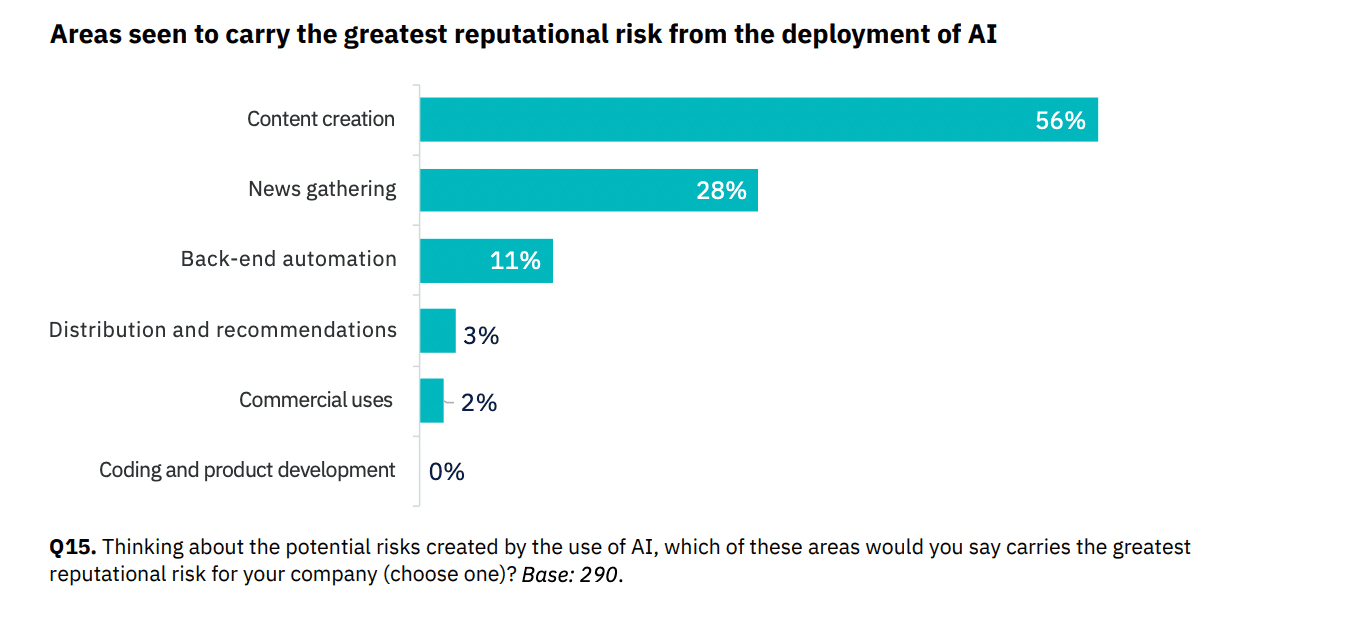5 AI trends shaping news production and what they mean for media leadership
20 Feb 2024
What are the key trends in AI in journalism, and what do they mean?
AI has long been the biggest topic in the media world, but there is little coverage of how news organisations are using AI and the impact they are seeing. Here’s a selection of ways AI is currently used to produce and distribute news and what predictions related to AI developments mean for the publishing industry.
At the end of 2023, we published our trend book, The Newsroom of Tomorrow, focusing on innovations in the media industry. AI clearly emerged as a leading trend for 2024, and there were more and more examples of the effective use of AI in newsrooms.
At the same time, it became clear that the acceleration of progress in AI and its impact on newsrooms is one of the biggest challenges for publishers – especially in the context of ethical and legal constraints, including intellectual property and news credibility.
Several months have passed since then – and where are we now? What’s happening with AI in the media? What are the key trends in AI in journalism, and what do they mean?
To answer these questions, we analysed several major reports to distil the essence of AI disruption in the media, including:
-
The report from the Reuters Institute for the Study of Journalism, based on input from 314 news leaders from 56 countries and territories;
-
Felix M. Simon’s outstanding report How does AI change the news, based on 170 interviews with industry/academic experts and employees at 35 publishers;
Here’s the essence of what you need to know from these reports. We focused on five key points, relevant to any change leader in the media industry or any executive involved in implementing new solutions and editorial tools – so let’s jump right in.
1) AI uses which are and will be key for news publishers in 2024
The most important uses of AI in news organisations are:
- Back-end automation tasks (56%)
- Recommendation system (37%)
- Content creation (28%)
- Commercial uses (27%)
- Product development (25%)
- Newsgathering (22%)
(data according to Reuters Institute for the Study of Journalism)
As you can notice, the key area where AI is being used and will be used this year is the back-end automation. This field, along with content creation, are now much more important than two years ago, which is consistent with more specific examples of how newsrooms leverage AI. These are:
- Summarisation – adding bullet points to the top of articles
- Headline testing – AI-driven headlines optimised for search
- Copyediting, notetaking, and transcription
- Translation
- Image generation
- Article generation
(data according to Reuters Institute for the Study of Journalism)
Maybe you already use AI to streamline your team’s tasks in these areas. If not, you can see what such mechanisms look like when implemented into a CMS. Here’s our piece on AI concepts for newsrooms with 25+ animations of AI-based possible solutions.
One more thought on this. AI is being used for a variety of tasks, but the complex realities of publishing often limit how and when the technology can be practically utilised. This means that while efficiency and productivity gains are real, they do not always apply to the entire organisation or to the entire editorial process.

2) Content creation with AI carries the biggest reputational risk
Various levels of risk are associated with using AI, depending on the area. Content creation is seen as posing by far the biggest danger (56%), followed by newsgathering (28%). By contrast, back-end automation (11%), distribution, and coding are considered lower risk. This explains the higher level of focus right now on these back-end efficiencies and more caution around robo-journalism of different kinds.
This means that most media organisations will not jump into AI-generated content in 2024, at least not at scale. Many newsrooms pride themselves on publishing trustworthy and reliable news and will need a handbrake on some AI-led systems. We have seen some severe lay-offs, especially in the American media, but the rumour that “AI is going to replace humans” is largely exaggerated.
It also means we will see new roles appointed in newsrooms and people coordinating AI activities and strategies. According to Reuters, 16% of newsrooms had already done so, with 24% actively planning to do so. If that’s not on your agenda – it’s time you reconsider.

source: Reuters Institute for the Study of Journalism
3) AI’s impact is highly context-dependent
AI definitely has the potential to enhance efficiency within news organisations, but productivity gains will not be straightforward.
For example, AI can enrich the podcast experience, providing users with additional information and recommendations based on their listening history. This process can be done at scale, as algorithms process large amounts of data in a reasonable amount of time and with minimal effort, and all this is done to deliver a better experience to the audience. Another example is the area of transcriptions we have mentioned before – here, AI makes a significant, measurable difference in the work of journalists, primarily because of significant time savings.
On the other hand, it happens that something produced by AI is of poor quality and needs to be rechecked by a human, which decreases efficiency. This is common for large language models prone to errors and producing unreliable results, hindering the journalistic process rather than streamlining it. As for now, we need to oversee the task execution by AI, and we need a human-assisted process before we fully delegate serious matters to algorithms. Here’s more on how we can solve this problem.
It’s not a given then that AI will free news workers to do deeper or better journalism. Especially because the time journalists save using AI is usually devoted to extra work, writing more stories, or editing more videos. Also, since AI is still mostly used as a tool, it doesn’t fundamentally affect how newsrooms operate.
4. Publishers will rely on platform AI infrastructure and services
For now, platform companies – Google, Meta, Microsoft – are leaders in developing and applying artificial intelligence, and most news organisations depend on them. “You can’t use AI without using these companies in some way”, say publishers who use the tools provided by tech giants to automate editorial tasks and distribute their content. This use is expected to increase in the future when generative AI apps become even more common.
Bigger (and richer) media organisations will probably try to develop in-house AI-assisted tools through their R&D teams, but the costs of custom AI development will likely remain high.
This phenomenon can raise some serious concerns about journalistic autonomy. We have observed a similar situation with the rise of social media, with Facebook, Twitter (now X) and Instagram dictating the content formats. This time, the case is even more severe because it determines the journalistic output and the credibility of information.
Another consequence is that “winners” and “losers” will emerge (or have already emerged). Those news organisations that invest in research and development and build their technical infrastructure are likely to win in this race, have a stronger position and possibly even negotiate terms of use with AI platforms and tech giants. We will see more and more publishers building barriers to their content or not letting LMMs scan it as the source of information – as The New York Times, Reuters, and CNN did last year. At the same time, such an attitude might make it more challenging for the media to reach younger or less wealthy audiences, who become more and more comfortable with algorithmically generated news and have weaker ties to traditional media.

5. AI will not be the solution to core problems of editorial workflows
It may sound trivial, but AI is just technology – and as such, it can’t solve any problems, especially those related to editorial workflows or outdated internal systems. If journalists and editors don’t have reliable tools to work on, and the media organisations remain in technological debt, AI will not be a panacea for those pain points.
It will also not replace journalists, product managers or audience analysts. And if it does, will we speak of journalism or maybe more of “making the news”? As of today, many journalists work just from their desks, which contributes to delivering a relatively narrow view of the world to the audience.
This is also why newsrooms need serious product leaders who will connect the dots between technology, journalism, and business, work on journalistic processes, and create a “product” culture. They also need solid tech infrastructure and modern tools to ensure news is delivered quickly and without obstacles. More than AI, many newsrooms need basic editorial software, back-office systems, or simple automation that can streamline processes and improve productivity.
Digital leaders remain optimistic
One more thought before we close. Despite the unprecedented development of technology and insecurities about the future, almost half of CEOs and digital executives (47% according to the Reuters Institute for the Study of Journalism) say they are confident about the prospects for journalism in the year ahead, and only one-tenth (12%) expresses low confidence.
Some news executives are optimistic, thinking that the upcoming surge of unreliable synthetic content might benefit journalism and rebuild trust. On the flip side, others are concerned that people may lose trust in all information, posing a threat to democracies globally. This year will provide more insights into which scenario unfolds and how eager governments are to regulate the influence of AI giants.
The impact of AI on journalism won't be bad or good for the media industry. It comes down to how it's used, technical challenges, organizational factors, and a company's culture and willingness to innovate. Either way, watching AI, humans, and machines collaborate in a new era of journalism will be interesting. You can read more about how integrating AI tools into the newsroom's CMS can revolutionise the publishing process or take a look at an article about introducing to AI strategy for news organisations.



